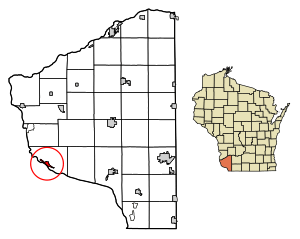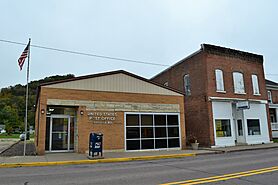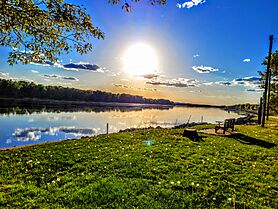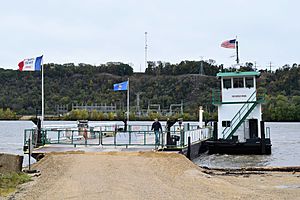Cassville, Wisconsin facts for kids
Quick facts for kids
Cassville, Wisconsin
|
|
|---|---|
|
Top: U.S. Post Office, Bottom: Riverside Park
|
|

Location of Cassville in Grant County, Wisconsin.
|
|
| Country | |
| State | |
| County | Grant |
| Area | |
| • Total | 1.10 sq mi (2.85 km2) |
| • Land | 1.04 sq mi (2.69 km2) |
| • Water | 0.06 sq mi (0.16 km2) |
| Elevation | 633 ft (193 m) |
| Population
(2020)
|
|
| • Total | 777 |
| • Density | 747.8/sq mi (288.7/km2) |
| Time zone | UTC-6 (Central (CST)) |
| • Summer (DST) | UTC-5 (CDT) |
| Area code(s) | 608 |
| FIPS code | 55-13050 |
| GNIS feature ID | 1582927 |
Cassville is a small village in Grant County, Wisconsin, United States. It's located right along the Mississippi River, which is a very famous and important river in America. In 2020, about 777 people lived here. The village is surrounded by the Town of Cassville.
Contents
What's in a Name?
Cassville got its name from Lewis Cass. He was the governor of the Michigan Territory a long time ago, from 1813 to 1831. People have been using the name Cassville for this community since at least 1828. That's when the first post office was set up by Allen Hill.
A Look Back: Cassville's History
Before European settlers arrived, the area where Cassville is now was home to the Meskwaki people. In 1820, a traveler named Henry Schoolcraft saw a Meskwaki village there. It had twelve strong log lodges and fields where they grew crops.
Early European Settlement
European settlement in Cassville started in 1827. Judge John Sawyer from Illinois built a special furnace there. This furnace was used to melt lead, which was mined by people moving north from Galena, Illinois. In its first year, about 60 to 70 people moved to the town. By the early 1830s, Cassville had several log cabins, a place to eat and stay (a tavern), a general store, and a small fort called a blockhouse. This fort was built during the Black Hawk War to protect the settlers.
The Capital City Dream
Cassville had a short period of fast growth in 1836. This happened because some people thought it would become the capital city of the new Wisconsin Territory. A group of investors from Albany, New York, bought most of the town's land. They also paid to build the Denniston House, a large brick building that cost a lot of money back then.
But Cassville didn't become the capital. This, along with a money crisis in 1837 (called the Panic of 1837), stopped the town's growth. For the next ten years, much of the land was caught up in legal problems.
Nelson Dewey's Influence
Nelson Dewey moved to Cassville in 1836. He worked for the same investors who built the Denniston House. Later, he became the very first Governor of Wisconsin, serving from 1848 to 1852.
After being governor, Dewey helped finish the Denniston House, turning it into a hotel in the 1850s. He tried to help Cassville grow, but it was still slow. In the 1860s, Dewey built his own large home and property called Stonefield just north of Cassville. Today, part of this land is Nelson Dewey State Park. In 1953, the Wisconsin Historical Society opened the Stonefield Historic Site at Dewey's old mansion.
Where is Cassville?
Cassville is located at 42°42′55.34″N 90°59′26.08″W / 42.7153722°N 90.9905778°W. The village covers about 1.1 square miles (2.85 square kilometers) in total. Most of this area, about 1.04 square miles (2.69 square kilometers), is land. The rest, about 0.06 square miles (0.16 square kilometers), is water.
How Many People Live Here?
| Historical population | |||
|---|---|---|---|
| Census | Pop. | %± | |
| 1870 | 551 | — | |
| 1880 | 610 | 10.7% | |
| 1890 | 886 | 45.2% | |
| 1900 | 979 | 10.5% | |
| 1910 | 890 | −9.1% | |
| 1920 | 899 | 1.0% | |
| 1930 | 875 | −2.7% | |
| 1940 | 956 | 9.3% | |
| 1950 | 984 | 2.9% | |
| 1960 | 1,290 | 31.1% | |
| 1970 | 1,343 | 4.1% | |
| 1980 | 1,270 | −5.4% | |
| 1990 | 1,144 | −9.9% | |
| 2000 | 1,085 | −5.2% | |
| 2010 | 947 | −12.7% | |
| 2020 | 777 | −18.0% | |
| U.S. Decennial Census | |||
2020 Census Facts
In 2020, the population of Cassville was 777 people. There were 514 homes in the village. Most residents, about 95%, were White. A small number of people were Asian, Black, or Native American. About 1.2% of the population was Hispanic or Latino.
2010 Census Facts
In 2010, there were 947 people living in Cassville. There were 428 households, which are groups of people living together in a home. About 24.5% of these households had children under 18. Many households (50.5%) were married couples. The average household had 2.21 people. The average age in the village was 48.3 years old. About 20.8% of residents were under 18. About 23.7% were 65 or older. The population was almost evenly split between males (49%) and females (51%).
Local Economy
Cassville used to have two power plants: the Nelson Dewey Generating Station and the E. J. Stoneman Generating Station. These plants produced electricity for the area. Both of these power plants closed down in 2015.
Getting Around Cassville
- Cassville Car Ferry: From late spring to early fall, you can take the Cassville Car Ferry across the Mississippi River. It connects Cassville to rural Clayton County, Iowa. Sometimes, if the river water is too high, the ferry might not run.
- Cassville Municipal Airport: The village also has its own airport, called the Cassville Municipal Airport. It's located about 1 mile southeast of the village, right by the Mississippi River.
Famous People from Cassville
- Joseph Bock: A soldier and a member of the Wisconsin State Assembly (a group that makes laws for the state).
- Nelson Dewey: The very first Governor of Wisconsin, serving from 1848 to 1852.
- Patrick H. Kelly: An educator and also a member of the Wisconsin State Assembly.
Images for kids
See also
 In Spanish: Cassville (Wisconsin) para niños
In Spanish: Cassville (Wisconsin) para niños





